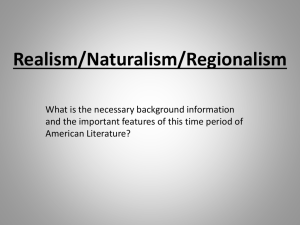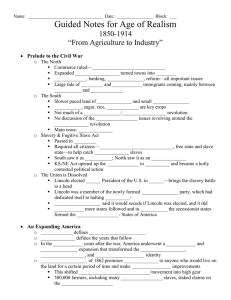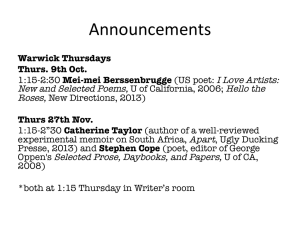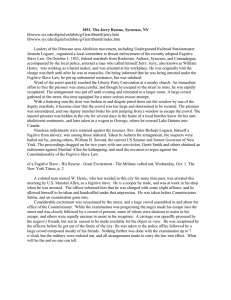Realism ppt revised
advertisement
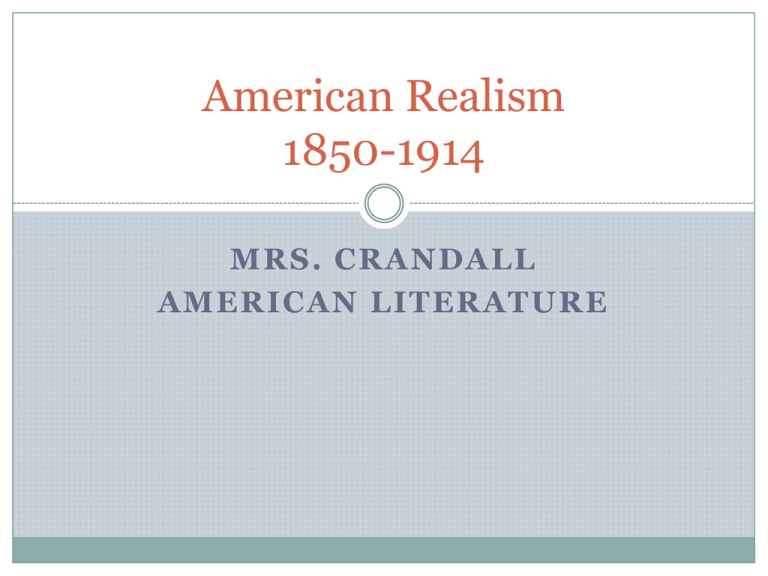
American Realism 1850-1914 MRS. CRANDALL AMERICAN LITERATURE What is Realism? Response to the Civil War Rejection of Romanticism Portrays “real life” as ordinary people lived Attempted to show characters and events in an honest, objective and factual way Psychological stories: focus on character motivation Regionalism Naturalism Realism Historical Background American North Northern Industrial Revolution- advances in education, banking and science Immigration- influx of Irish and German immigrants Agriculture- slow pace plantations Slavery- economy highly dependant on slave labor 1850 Fugitive Slave Act passed (mandated the return of fugitive slaves) 1854 Kansas- Nebraska Act 1859 Harpers Ferry West Virginia- slave revolt led by John Brown (later hanged for treason) Literary Connection Uncle Tom’s Cabin Harriet Beecher Stowe 1852 Became a powerful antislavery weapon More than 300,000 copies sold Vividly depicted the cruelty of slavery Uncle Tom’s Cabin Historical Timeline 1860- Abraham Lincoln elected as President of the United States 1861- Civil War begins April 12- Confederate fired on Union troops holding fort Sumter- started the Civil War 1865- Confederate General Robert E. Lee surrenders Just days later, Abraham Lincoln was assassinated (April 14, 1865) Soldiers Historical Timeline 1862- Homestead Act which encouraged westward expansion Promised land (160 acres) to Americans willing to move westward to inhabit and develop land on the Great Plains 1869- Transcontinental Railroad opened By 1890, virtually all Native Americans in the West had been forced from their land Industrial Revolution Began in the 1880’s after electricity was introduced Population just over 50 million By the turn of the century the population is about 76 million A significant portion was due to more than 9 million immigrants who came during this period Electricity replaced steam power Inventions: electric lights, telephone, automobiles, motion picture, and phonographs Led to a boost in consumer goods, advertising, skyscrapers, department stores Also led to pollution, crimes, slums, traffic jams Wealth and Poverty The industrial boom of the late nineteenth century created new extremes in wealth and poverty Wages of industrial workers were so low that a single worker, or even two, often could not support one family Child labor became the norm among the poor and working class Immigrant families often lived in small, dark, unventilated apartments without toilets In these conditions, disease was rampant! Literary Connections How the Other Half Lives Jacob Riis 1890 First expose documentary Powerful photography Exposed the living conditions of the poor working class citizens How the Other Half Lives How the Other Half Lives How the Other Half Lives Emergence of African American Literature Sojourner Truth- “An Account of and Experience with Discrimination” Fredrick Douglass- My Bondage and My Freedom Charles Chestnutt- Marrow of Tradition Stories were told through slave quilts and slave spirituals Regionalism Focus on specific geographical setting, dialects, landscapes, mannerisms, and cultural customs of a region Also called Local Color Fiction Mark Twain How’r y’all doin’ down yonder? Naturalism Naturalist writers also depicted real people in real situations, but they believed in forces larger than the individual- nature, fate, heredity- shaped individual destiny If the reality these writers depicted seemed to be a harsh one, it was because hardship influenced their artistic vision. It was a vision rooted in war, in the frontier, and increasingly, in America’s growing cities Also called Determinism Kate Chopin Jack London

